A Business Concept Proposal is a structured document that outlines the core idea of a business or project, its goals, target audience, and how it intends to solve a…
continue reading
8+ Sample School Safety Proposal
-
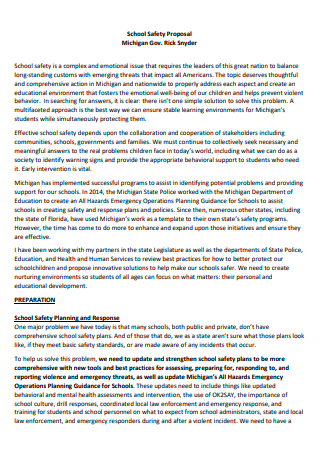
School Safety Proposal Template
download now -
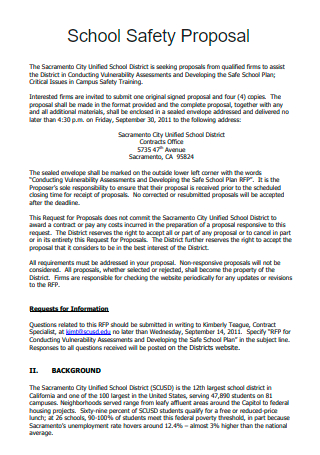
School Safety Proposal Example
download now -

School Security and Safety Proposal
download now -
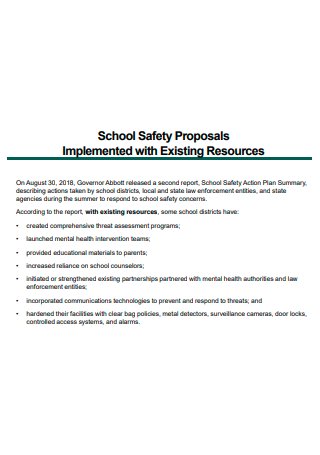
Printable School Safety Proposal
download now -
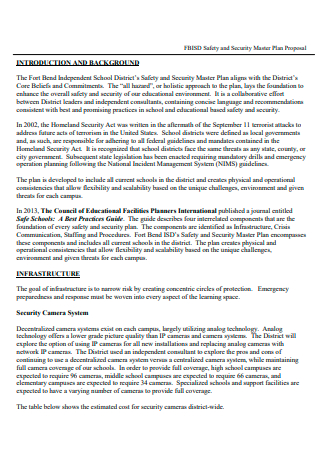
School Safety and Security Master Plan Proposal
download now -
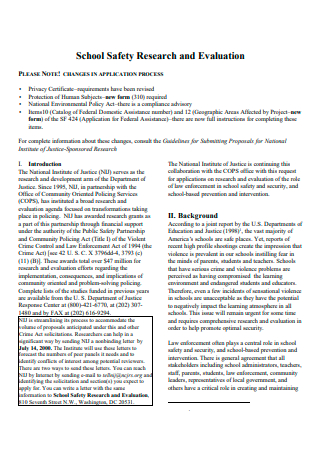
School Safety Research and Evaluation Proposal.
download now -
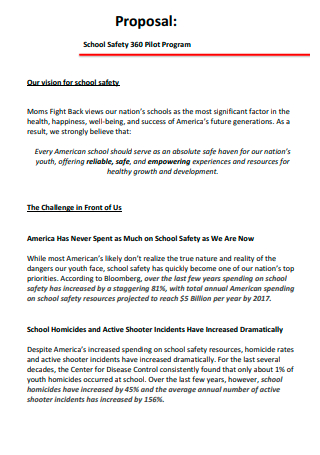
School Safety Pilot Program Proposal
download now -

Middle School Safety Proposal
download now -
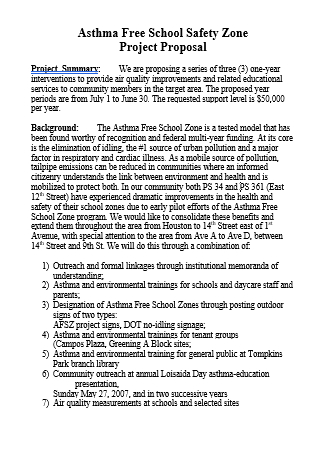
School Safety Zone Project Proposal
download now
What Is a School Safety Proposal?
A School Safety Proposal is a written document that proposes, or put forward for consideration or for approval, a project, a service, or sets of strategies that either would satisfy or meet the school’s need for safety and protection. It usually presents current conditions and environmental factors that merits the need to improve, further develop, or add more safety, preventative, and/or precautionary measures in place. Issues that are usually addressed in a school safety proposal include physical violence such as bullying, or any other aggressive behavior that inflicts physical, mental, and emotional trauma; school hazards, and natural disasters. Sometimes, a proposal is in the form of a contingency plan or a school emergency plan. For a school safety proposal to be effective, all the stakeholders (such as student learners, teachers, school staff, administration and personnel, the parents and the community) should be on board and cooperate with the safety measures presented. Active cooperation and a good communication plan between the school stakeholders and the local government and the local enforcement agencies is needed as well.
4 Reasons Why a School Safety Proposal is Important
At the very core of a school safety proposal is the intent to create strategies to improve and develop the school’s safety regulation and protocols. Therefore, the proposal should be up to date with the latest safety protocols and applicable law mandates. Aside from guaranteeing the safety of everyone within the school’s premises, the school safety proposal should also aim for spreading knowledge and awareness on safety campaigns. Hence, the proposal later on, once approved, will serve as a guide and as a roadmap to start implementing safety measures. Before starting to create a school safety proposal, it is important to understand how everybody could benefit from it. Here are the top four reasons that outline the importance of having a school safety proposal.
How To Create a School Safety Proposal
Knowing the importance of having a school safety proposal is one step forward to creating one. The proposal should take into consideration all the parties that will be affected by the proposed action steps needed to address concerns pertaining to a school’s safety and security. There is no hard and fast rule when formatting a school safety proposal. At the end of the day, the goal here is to get everybody on the same page as to the goal and the intent of the proposal, and have it approved by the appropriate authorities. Once approved, the proposal can then serve as a roadmap to start implementing and putting in place the security and safety measures needed. Here are the common steps when writing a school safety proposal.
Step 1: Creating a Cover Letter
The cover letter will serve as your introduction to yourself and the organization that you are representing. Generally, a cover letter is intended to set an appointment to make a presentation about a project or a service. Your cover letter will be your first impression on getting your school safety proposal considered, and eventually approved. Create a cover letter that’s short and concise. Avoid being verbose and go straight to the intent of your letter. Consider that your readers are usually on a tight schedule. Show to them that you appreciate their taking the time to read your letter, but nevertheless, make it a short and brief introduction as much as possible.
Step 2: Making an Executive Summary
An executive summary is a brief outline and description of your proposal. It should be able to describe what problems or concerns the proposal is addressing, and a short summary of how it plans to address those concerns. A good executive summary should be concise and catchy enough to be able to grab hold the readers’ or the audience’s attention. Also, it is a determining factor if the rest of your proposal is good enough for your readers to spend their time on. In the case of a school safety proposal, your executive summary should contain an itemized list of existing issues or potential issues that will impact the school’s safety and security. It should also include who are the stakeholders involved and affected, such as the student learners, the teachers, the principal and school staff, the parents, the community, and/or the school district board.
Step 3: Present the School’s Overall Safety Assessment
This is the part where you present an overall assessment of the school’s existing safety and security measures, if any. Also, this is where you highlight and delve in deeper what are the safety and security existing risk factors or potential risks that the school is or will be facing. You can also mention existing safety protocols and procedures that either need to be changed or improved, or introduce new sets of protocols that need to be adopted. When mentioning the protocols and procedures, or rules, give a brief background on how these rules were formed, what were the circumstances back then, and make a comparison to the present situation. Give an overall analysis if these rules are still relevant to the current situation, and if not, what makes the new rules that you will be introducing more relevant and significant. Show the gravity of the impact and the need why these rules need to be implemented by doing a pros and cons side by side comparison. You can also mention if there are any existing legislations and mandates that support for these rules to be implemented within the school’s system.
Step 4: Creating Prevention and Response Strategies
These strategies are the action steps that will be the highlight of your entire proposal. Prevention actions, or preventative measures, are those that seek to prevent, or avoid, an adverse event or harm from happening in the school. These are known as precautionary measures. Response strategies are those immediate steps taken to respond to a negative event that already happened within the school, either to offer remedy or to mitigate the impact caused by such an incident. In bullying, prevention could be in the form of doing an information awareness drive campaign to identify signs of bullying or of being bullied, what are the negative impacts caused by bullying, and how to seek help if someone is a victim of bullying. For any other threats or acts of physical violence, everyone in the school should have the contact details of the emergency response team or the local police if there is any need to report an ongoing violence, or a potential situation that will lead to violence. There should also be training conducted within the school on how to react in case of a fire, having an earthquake action plan, or having a disaster recovery plan in place. Adding security guards is also another safety measure.
Step 5: Equipment and Materials Needed
This is the part where you identify what are the equipment and materials needed to be able to implement the strategies that you presented. Equipment and materials could be in the form of additional and updated fire extinguishers, replacing obsolete or malfunctioning power outlets and tools, or a proper storage area for dangerous tools. Materials could also come in the form of educational flyers or printed handouts on safety measures and precautions that students can take home with them.
Step 6: Identifying Implementing Teams and their Responsibilities
This is where you name the individuals or teams who are tasked to implement the strategies, along with their specific roles and responsibilities. Ideally, there should also be an emergency response unit within the school system, aside from the local community’s emergency response team. This school’s emergency response team should be the first responders, and should be tasked with performing immediate first aid as necessary, and the point of contact if there are any emergencies or violence happening within the school premises. Their names and contact details should be distributed within the school community.
FAQs
What are some of the ways to address school hazards?
One of the ways to address and prevent school hazards is by doing a regular check and maintenance of the school surroundings. This includes checking the overall school building safety structural integrity, if it’s still up to date with the local building code regulations to be able to withstand any type of disasters, or if there is a need to do some renovations for safety purposes. Checking and maintenance can also be in the form of ensuring that hazardous equipment is kept and stored properly, fire extinguishers are available, as well as fire exits are easily accessible. Proper school ground lighting needs to be checked also.
Is sexual harassment also addressed in a school safety proposal?
Yes, sexual harassment is also taken up and addressed by a school safety proposal. In fact, any kind of negative circumstances that cause physical, mental, and emotional harm or trauma is ideally addressed in a school safety proposal.
What are the common safety rules being taught to students?
The number one safety rule being taught to students is to always be alert, vigilant and aware of their surroundings. Next is teaching them the contact information of emergency response services or persons in authority that they can approach and seek help if the need arises. Proper emergency procedures are also taught, such as what to do in case of a fire or a natural disaster, and recognizing emergency labels and routes to follow.
The safety and security of everyone inside the school premises should never be compromised. Aside from following existing local government’s regulation and mandates on school safety, everyone should be on board to cooperate, implement, and even add-on additional measures to further strengthen the school’s preparedness and protection. Oftentimes, negative incidents are unpredictable, so the best way for a school to prepare is to plan out strategies to prevent those from happening or else to mitigate and remedy its impact when it does happen. These are all laid out and presented in a school safety proposal.
If you’re in charge of the overall security and protection of your school, our school safety proposal template can be able to help you formulate your presentation on proposing school safety measure strategies. It’s easy to fill out and follow through. Download one now, and start making plans in securing your school’s safety and protection!

![25+ SAMPLE Marketing Budgets [ Business, Plan, Digital ] marketing budgets](https://images.sample.net/wp-content/uploads/2021/02/Marketing-Budgets.jpg)